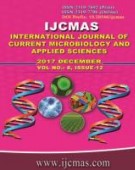


 National Academy of Agricultural Sciences (NAAS)
National Academy of Agricultural Sciences (NAAS)

|
PRINT ISSN : 2319-7692
Online ISSN : 2319-7706 Issues : 12 per year Publisher : Excellent Publishers Email : editorijcmas@gmail.com / submit@ijcmas.com Editor-in-chief: Dr.M.Prakash Index Copernicus ICV 2018: 95.39 NAAS RATING 2020: 5.38 |
In the present study an attempt was made for transformation of fish market waste into silage by using three different methods: Inorganic (98% sulphuric acid with weight percentage of 2.5, 3.5 and 4.5%), organic (98% formic acid with weight percentage of 2.5, 3.5 and 4.5%) and biological method (molasses with weight percentage of 5, 10, 15% and curd used as lactic acid bacteria source for fermentation). The chemical, microbiological and nutritional properties of the differently preserved fish silages were estimated during a storage period of 60 days at ambient temperature. The important findings are summarised as the rate of pH, AAN and TVB-N values were gradually increased and then get stable. In case of biological silage 10% and 15 % molasses pH was decreased below 4.5 after 72 hours. The rate of autolysis in sulphuric acid silage was slow compared to formic acid and biological silage. In case of bio-fermented silage (15% molasses) a steady supply of nutrients from molasses showed a steady increase in LAB from 2.24×106 to 3.67×109cfu/g and then decrease. TPC was decreased from 4.50×106 to 8.20×103cfu/g. In present study, sulphuric acid 2.5%, formic acid 2.5%, biological silage 5 and 10% silages were corrupted at the end of 24, 24, 12 and 30 days respectively. The appropriate amount of sulphuric acid, formic acid and molasses for preparation of fish silage were determined as 3.5%, 3.5% and 15% respectively.
 |
 |
 |
 |
 |